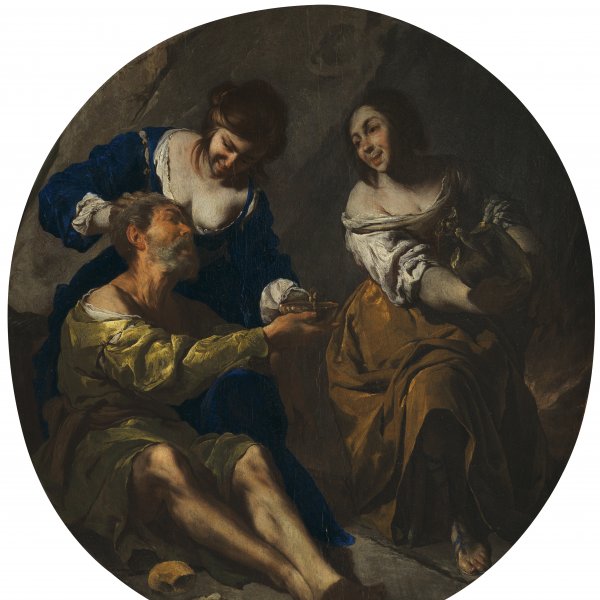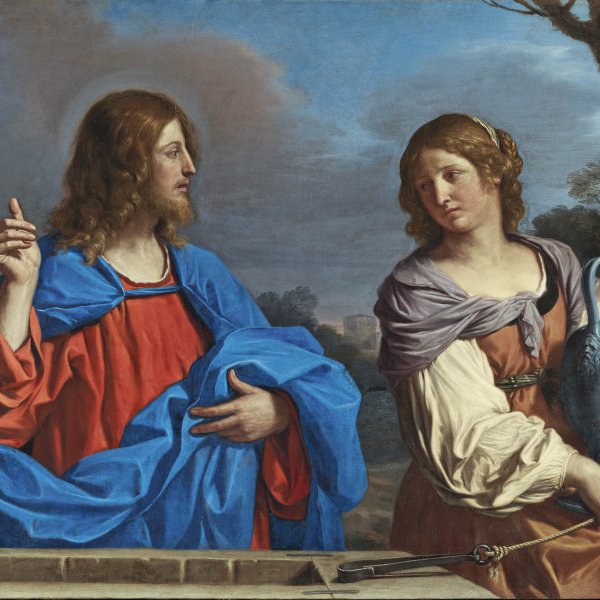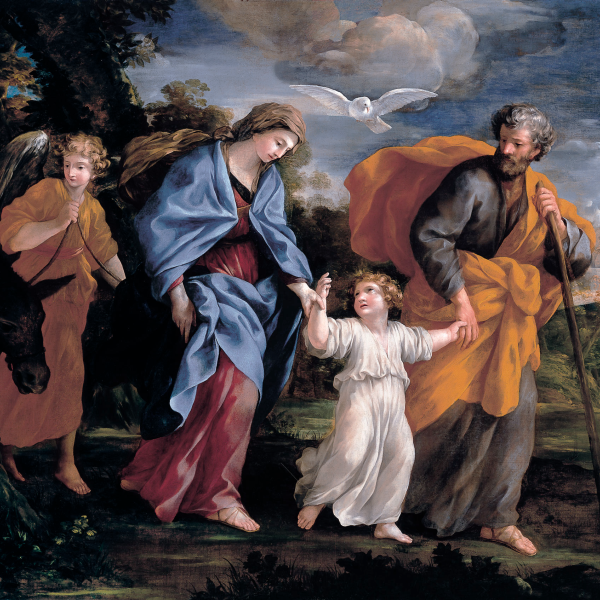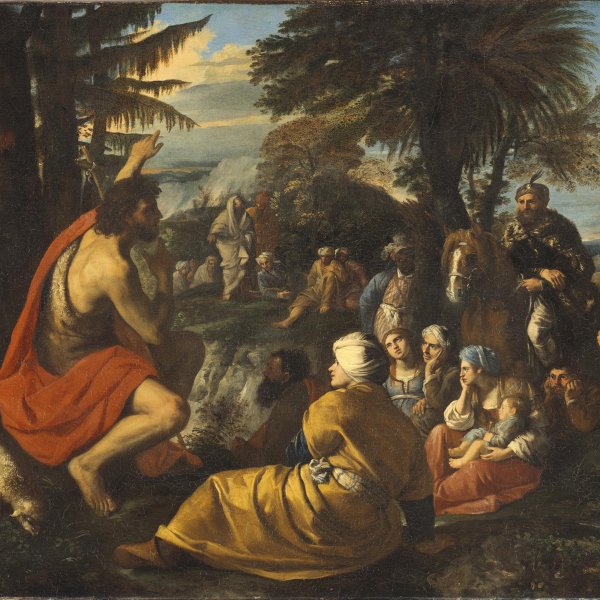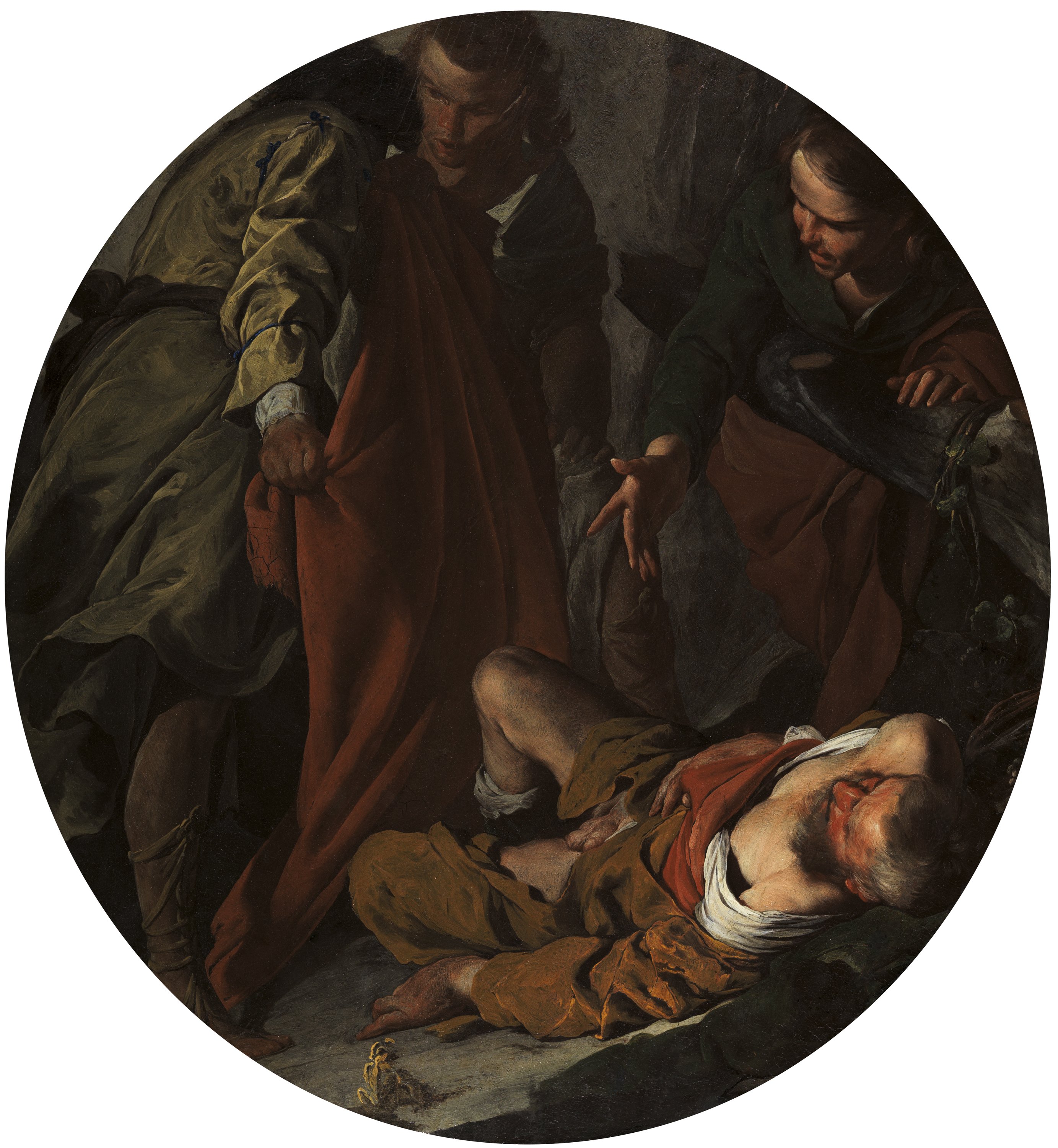The Drunkenness of Noah
ca. 1640 - 1645
Oil on panel.
41 x 37.7 cm
Carmen Thyssen Collection
Inv. no. (
CTB.1994.3.2
)
Room 14
Level 2
Permanent Collection
After the Council of Trent, this pairing of subjects became very common due to their strong moral messages: the two scenes depict a drunken father unwittingly led to commit incest so as to continue the human race following the flight from Sodom (Genesis. 19, 30-35), and a father who had survived the flood with his family, lewdly inebriated having drunk the wine from his own vineyard (Genesis. 9, 20-23). The technical challenges to artists in depicting these scenes included the representation of the implied contrasts of sex and age, for example, between the burnished skin colour of the elderly protagonists and those of their offspring, particularly of the daughters of Lot.
The two panels are in good overall condition but feature numerous areas of old repainting. On the reverse of the panel with the story of Lot is a label with the number 147, another old label with a wax seal with a lion rampant and a second wax seal with an emblem with a putto and the phrase "Soyez fidelle." These suggest that the painting passed through the hands of a French collector with a family coat of arms. An illegible wax seal beside the label with the number 146 is also on the reverse.
Among the finest pairs of paintings by this Neapolitan artist who died young in his early forties by the plague of 1656, they belongs to his more mature phase and are close to the date of 1645 of his only dated picture, the Saint Cecilia temporarily exhibited in Palazzo Vecchio in Florence, along with other works recovered in Germany by Rodolfo Siviero.
Despite previous critical efforts, the dating of Cavallino's work still remains very uncertain. Critics tend to see the larger and more spacious works as later, particularly those with livelier and more varied colouring, while the less robust, more evanescent works, particularly those whose colouring is marked by harsher contrasts between light and dark tones, are treated as youthful productions. However, this arrangement is notably contradicted by the desire to place at the very beginning of Cavallino's oeuvre the much discussed picture in the Museum in Budapest of The Meeting of Anna and Joachim, characterised by its generically Spanish and Riberian elements in particular, as well as Spanish-Neapolitan elements recalling the Master of the Annunciation to the Shepherds as well as Stanzione. This combination certainly points to Cavallino, a worthy pupil of Stanzione, but the very fact that the picture must necessarily be regarded as an early work leads in this author's view to review the justification for placing other paintings of slighter formal construction among early works since they are antithetical to the spirit which informs the great Budapest picture. Among such works we find the Riberian Martyrdom of Saint Bartholomew in the Capodimonte Museum and the Communion of the Apostles in a private collection in Milan. Noting Ribera's influence in Cavallino is an elementary exercise. The confirmation of the influence of the Valencian artist can be found throughout his works, including the street urchin's face and the sardonic smile of the daughter who pours the wine for her father on the right of the Lot tondo. It is difficult to imagine that the contours of this face, quite close to that of the youthful figure behind Anna in the Budapest picture and perhaps even closer to that of the youth with the lamb over his shoulder on the opposite side of that picture, are not influenced by Ribera's examples. These might include the Drinker (or the Allegory of Taste) in a private collection in Geneva and particularly its pendant representing a Girl with a Tambourine (or the Allegory of Hearing), with the Drey Gallery in London. Both are dated 1637 and could certainly have fired the imagination of the young Cavallino, barely in his twenties.
Though not numerous, other examples displaying this sombre chromatic richness (though on this count there is virtually no correspondence with the dated Saint Cecilia in Florence), the formal vigour and expressive powers evident in this excellent pair of panels are sufficient in number to confirm Cavallino's hand. Lot's inebriated face is the direct descendant of the drier but physiognomically identical Saul who is lost in thought while listening to David in the earlier canvases with the Heim Gallery in London, David Playing the Harp in Front of Saul, and also of that of Tobias in Tobias Restores his Father's Eyesight in the Staatliche Kunstsammlungen in Kassel. In this later picture, however, the entire figure of the elderly man who is about to regain his eyesight bears a strong resemblance to that of the Thyssen Lot, while, moreover, the somatic identity of the loving Tobias with the son of Noah in the centre of the tondo who points to the indecent drunkenness of his father, is evident. The exceptionally elegant Kassel picture is probably earlier by a couple of years and undoubtedly touches upon the style of Andrea Vaccaro. Also revealing this same, virile but elderly masculine typology is the older shepherd in the tondo of Erminia among the Shepherds in the Alte Pinakothek in Munich.
Overall, the mode of representation of another excellent painting in Germany, the Finding of Moses in the Herzog Anton Ulrich Museum in Braunschweig, is quite close to the all-embracing circularity of the two Thyssen tondi, although the lyrical joyfulness of the former work changes to dramatic snapshots compressed into powerfully expressive clauses in the latter. The ideal or most easily true model for the leaning woman who closes the right side of the German canvas is the same as that for the son of Noah of the right. He, in turn, derives from an almost certainly earlier composition with the same theme (Gosford House, Earl of Wemyss and March), in which the young man is shown to the viewer in almost the same pose -note the similar gesture of the right hand- but with a more generic definition of the body, as is customary for the works that are presumed to date from Cavallino's youth. The Gosford House painting (an oval canvas, considerably deal larger than the Thyssen tondi: 103.5 x 78.7 cm) is itself a pendant, just as is the Madrid panel, to a Lot and his Daughters in the Louvre, conceived very differently from the present composition.
The richness of the message conveyed by these magnificent tondi in Madrid corresponds to that found in the masterpieces of the artist's maturity which Cavallino attained in his thirties. The more "monumental" trend within his paining -however extravagant this definition may seem for an artist who generally, though not exclusively, worked in smaller formats- finds expression in the famous Saint Cecilia dated 1645, as well as in the model which probably served as its preparatory study, now in the Capodimonte Museum. The roguish face of the angel and the typical depiction of the open hand with its tensed fingers spread apart correspond quite closely to both the morphological traits and to the style of The Drunkenness of Noah. These two types of coincidences, easily retraceable independently of one another, re-occur in rare cases. One such is the Pietá in the Picture Gallery of the Seminary of Molfetta, in whose figure of Christ we recognise the mirror image of the Thyssen Lot, while the parallel between the Virgin with her angular gesture and the more animated son of Noah, though not drawn so automatically, still seems no less convincing. The earth tones that harmonise the two panels in a realist direction (though they appear especially in Noah, since the scene of Lot tends towards a genre picture) provide a warm yet severe tonal key with the injections of greens (with yellow reflections as in Lot's tunic and the shirt of Noah's son with his back to us) and of reds (the blanket with which the sons intend to cover their father). We are in effect confronted with two paintings that are more Spanish (Velázquez, Murillo) than Neapolitan, stripped of the neo-Venetian chromatic elements which remain in one's mind as Cavallino's personal trait and whose source lies firstly in Ribera's presence in Naples and in the work of the Sicilian Novelli, who both derived these stylistic traits from Van Dyck, as well as in the Genoese artist Giovanni Bernardo Castiglione. Following the rediscovery of Titian and of his magical colouring as it was reinterpreted especially by Flemish painters, even Naples in the early 1640s saw a loosening of the reins of its doctrinaire naturalism, but without ever completely denying it. Cavallino was one of the major figures of this new tendency and it is particularly intriguing to find tangential contact between the style of these panels and the manner of Castiglione, or of the Neapolitan artists who were influenced by him (such as Andrea de Lione). The careful structuring of the two episodes, especially that of Noah, where the curved back of the son on the left follows the curvature of the frame, leads one to believe that this was their original format. This provides us with a clear indication of the powerful pithiness of Cavallino's invention, one truly worthy -in completely different times- of Caravaggio.
Roberto Contini
The two panels are in good overall condition but feature numerous areas of old repainting. On the reverse of the panel with the story of Lot is a label with the number 147, another old label with a wax seal with a lion rampant and a second wax seal with an emblem with a putto and the phrase "Soyez fidelle." These suggest that the painting passed through the hands of a French collector with a family coat of arms. An illegible wax seal beside the label with the number 146 is also on the reverse.
Among the finest pairs of paintings by this Neapolitan artist who died young in his early forties by the plague of 1656, they belongs to his more mature phase and are close to the date of 1645 of his only dated picture, the Saint Cecilia temporarily exhibited in Palazzo Vecchio in Florence, along with other works recovered in Germany by Rodolfo Siviero.
Despite previous critical efforts, the dating of Cavallino's work still remains very uncertain. Critics tend to see the larger and more spacious works as later, particularly those with livelier and more varied colouring, while the less robust, more evanescent works, particularly those whose colouring is marked by harsher contrasts between light and dark tones, are treated as youthful productions. However, this arrangement is notably contradicted by the desire to place at the very beginning of Cavallino's oeuvre the much discussed picture in the Museum in Budapest of The Meeting of Anna and Joachim, characterised by its generically Spanish and Riberian elements in particular, as well as Spanish-Neapolitan elements recalling the Master of the Annunciation to the Shepherds as well as Stanzione. This combination certainly points to Cavallino, a worthy pupil of Stanzione, but the very fact that the picture must necessarily be regarded as an early work leads in this author's view to review the justification for placing other paintings of slighter formal construction among early works since they are antithetical to the spirit which informs the great Budapest picture. Among such works we find the Riberian Martyrdom of Saint Bartholomew in the Capodimonte Museum and the Communion of the Apostles in a private collection in Milan. Noting Ribera's influence in Cavallino is an elementary exercise. The confirmation of the influence of the Valencian artist can be found throughout his works, including the street urchin's face and the sardonic smile of the daughter who pours the wine for her father on the right of the Lot tondo. It is difficult to imagine that the contours of this face, quite close to that of the youthful figure behind Anna in the Budapest picture and perhaps even closer to that of the youth with the lamb over his shoulder on the opposite side of that picture, are not influenced by Ribera's examples. These might include the Drinker (or the Allegory of Taste) in a private collection in Geneva and particularly its pendant representing a Girl with a Tambourine (or the Allegory of Hearing), with the Drey Gallery in London. Both are dated 1637 and could certainly have fired the imagination of the young Cavallino, barely in his twenties.
Though not numerous, other examples displaying this sombre chromatic richness (though on this count there is virtually no correspondence with the dated Saint Cecilia in Florence), the formal vigour and expressive powers evident in this excellent pair of panels are sufficient in number to confirm Cavallino's hand. Lot's inebriated face is the direct descendant of the drier but physiognomically identical Saul who is lost in thought while listening to David in the earlier canvases with the Heim Gallery in London, David Playing the Harp in Front of Saul, and also of that of Tobias in Tobias Restores his Father's Eyesight in the Staatliche Kunstsammlungen in Kassel. In this later picture, however, the entire figure of the elderly man who is about to regain his eyesight bears a strong resemblance to that of the Thyssen Lot, while, moreover, the somatic identity of the loving Tobias with the son of Noah in the centre of the tondo who points to the indecent drunkenness of his father, is evident. The exceptionally elegant Kassel picture is probably earlier by a couple of years and undoubtedly touches upon the style of Andrea Vaccaro. Also revealing this same, virile but elderly masculine typology is the older shepherd in the tondo of Erminia among the Shepherds in the Alte Pinakothek in Munich.
Overall, the mode of representation of another excellent painting in Germany, the Finding of Moses in the Herzog Anton Ulrich Museum in Braunschweig, is quite close to the all-embracing circularity of the two Thyssen tondi, although the lyrical joyfulness of the former work changes to dramatic snapshots compressed into powerfully expressive clauses in the latter. The ideal or most easily true model for the leaning woman who closes the right side of the German canvas is the same as that for the son of Noah of the right. He, in turn, derives from an almost certainly earlier composition with the same theme (Gosford House, Earl of Wemyss and March), in which the young man is shown to the viewer in almost the same pose -note the similar gesture of the right hand- but with a more generic definition of the body, as is customary for the works that are presumed to date from Cavallino's youth. The Gosford House painting (an oval canvas, considerably deal larger than the Thyssen tondi: 103.5 x 78.7 cm) is itself a pendant, just as is the Madrid panel, to a Lot and his Daughters in the Louvre, conceived very differently from the present composition.
The richness of the message conveyed by these magnificent tondi in Madrid corresponds to that found in the masterpieces of the artist's maturity which Cavallino attained in his thirties. The more "monumental" trend within his paining -however extravagant this definition may seem for an artist who generally, though not exclusively, worked in smaller formats- finds expression in the famous Saint Cecilia dated 1645, as well as in the model which probably served as its preparatory study, now in the Capodimonte Museum. The roguish face of the angel and the typical depiction of the open hand with its tensed fingers spread apart correspond quite closely to both the morphological traits and to the style of The Drunkenness of Noah. These two types of coincidences, easily retraceable independently of one another, re-occur in rare cases. One such is the Pietá in the Picture Gallery of the Seminary of Molfetta, in whose figure of Christ we recognise the mirror image of the Thyssen Lot, while the parallel between the Virgin with her angular gesture and the more animated son of Noah, though not drawn so automatically, still seems no less convincing. The earth tones that harmonise the two panels in a realist direction (though they appear especially in Noah, since the scene of Lot tends towards a genre picture) provide a warm yet severe tonal key with the injections of greens (with yellow reflections as in Lot's tunic and the shirt of Noah's son with his back to us) and of reds (the blanket with which the sons intend to cover their father). We are in effect confronted with two paintings that are more Spanish (Velázquez, Murillo) than Neapolitan, stripped of the neo-Venetian chromatic elements which remain in one's mind as Cavallino's personal trait and whose source lies firstly in Ribera's presence in Naples and in the work of the Sicilian Novelli, who both derived these stylistic traits from Van Dyck, as well as in the Genoese artist Giovanni Bernardo Castiglione. Following the rediscovery of Titian and of his magical colouring as it was reinterpreted especially by Flemish painters, even Naples in the early 1640s saw a loosening of the reins of its doctrinaire naturalism, but without ever completely denying it. Cavallino was one of the major figures of this new tendency and it is particularly intriguing to find tangential contact between the style of these panels and the manner of Castiglione, or of the Neapolitan artists who were influenced by him (such as Andrea de Lione). The careful structuring of the two episodes, especially that of Noah, where the curved back of the son on the left follows the curvature of the frame, leads one to believe that this was their original format. This provides us with a clear indication of the powerful pithiness of Cavallino's invention, one truly worthy -in completely different times- of Caravaggio.
Roberto Contini





